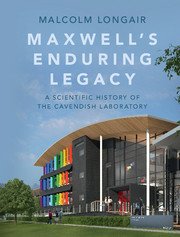Book contents
- Frontmatter
- Dedication
- Contents
- Preface
- Acknowledgements
- Part I To 1874
- Part II 1874 to 1879
- Part III 1879 to 1884
- Part IV 1884 to 1919
- Part V 1919 to 1937
- Part VI 1938 to 1953
- Part VII 1953 to 1971
- 13 The Mott era: an epoch of expansion
- 14 The Mott era: radio astronomy and high–energy physics
- 15 The Mott era: the growth of condensedmatter physics
- Part VIII 1971 to 1982
- Part IX 1984 to 1995
- Part X 1995 to present
- Appendix The evolution of the New Museums site
- Notes
- References
- Author index
- Subject index
14 - The Mott era: radio astronomy and high–energy physics
from Part VII - 1953 to 1971
Published online by Cambridge University Press: 05 July 2016
- Frontmatter
- Dedication
- Contents
- Preface
- Acknowledgements
- Part I To 1874
- Part II 1874 to 1879
- Part III 1879 to 1884
- Part IV 1884 to 1919
- Part V 1919 to 1937
- Part VI 1938 to 1953
- Part VII 1953 to 1971
- 13 The Mott era: an epoch of expansion
- 14 The Mott era: radio astronomy and high–energy physics
- 15 The Mott era: the growth of condensedmatter physics
- Part VIII 1971 to 1982
- Part IX 1984 to 1995
- Part X 1995 to present
- Appendix The evolution of the New Museums site
- Notes
- References
- Author index
- Subject index
Summary
The period of Mott's tenure of the Cavendish Chair from 1954 to 1971 was a revolutionary period in astronomy, astrophysics and cosmology. The nature of these disciplines changed in fundamental ways, highlights including:
• the emergence of high-energy astrophysics, in which high-energy particles and cosmic magnetic fields played a key role
• the discovery of the cosmological evolution of the radio source population
• the discovery of the cosmic microwave background radiation
• the discovery of pulsars, which were shown to be magnetised, rotating neutron stars.
The Radio Astronomy Group was at the centre of these events. At the same time, the Nuclear Physics Group changed direction from the earlier period when it was feasible for a University group to construct its own particle accelerators. The group was renamed the High Energy Physics Group in the mid 1960s, and successfully developed instrumentation and data analysis facilities in support of major international projects.
The growth of the Radio Astronomy Group
The story of radio astronomy in Cambridge up to 1953–54 was described in Section 12.7.2, the pivotal years when the discipline was about to develop into a ‘Big Science’ discipline. Ryle was the driving force behind these developments. As he wrote to me just before his death, he thought of himself primarily as an electrical engineer with the ability to make complex radio receiving systems a reality. In addition, however, he had remarkable physical intuition, which guided all his research activities in radio astronomy and its technology. His great contribution was the practical implementation of the concept of aperture synthesis, the technique by which images of the radio sky are created by combining interferometric observations made with modest-sized radio telescopes located at different interferometer spacings. Ryle's ambitious programme was to determine both the amplitudes and the phases of the incoming radio signals so that, by Fourier inversion, the detailed brightness distribution of the radio emission could be reconstructed. Although understood in principle, the key technical issues concerned whether or not these concepts could be realised in practice, given the problems of receiver sensitivity, the need to preserve phase coherence over long periods and the stability of the overall system performance.
- Type
- Chapter
- Information
- Maxwell's Enduring LegacyA Scientific History of the Cavendish Laboratory, pp. 335 - 357Publisher: Cambridge University PressPrint publication year: 2016



